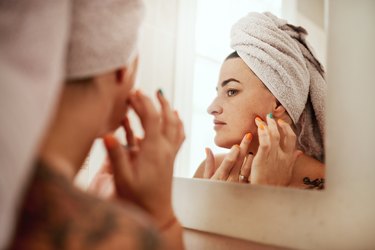
Injury, muscle aches and fatigue are a few of the more obvious signs you might be overdoing it when it comes to your fitness routine.
But take a closer look at the condition of your hair, skin and nails. All three can show surprising indicators that you might be overtraining.
Video of the Day
Video of the Day
At its most basic, overtraining, or overtraining syndrome as it's known in the medical world, is a condition caused by too much of a good thing: exercise. Over time, if you put stress on your body without giving it adequate time to recover, you can reach a point at which "the body is in a constant state of breakdown," endocrinologist and internist Elena Christofides, MD tells LIVESTRONG.com.
That breakdown might look like muscle weakness or injury, according to the American Council on Exercise. But overtraining syndrome can also lead to depression, agitation and insomnia — which makes it crucial to address ASAP.
There are two main contributors to overtraining syndrome: too much exercise and too little fuel. "You need [to take in] enough fuel to repair the damage that you're doing to your body during exercise," she says. When the two are out of balance, your risk of overtraining syndrome jumps up.
Stress, poor sleep, dehydration and alcohol use can also increase your odds of developing overtraining syndrome, Dr. Christofedes says.
How Overtraining Affects Your Hair, Skin and Nails
When overtraining makes itself known on your hair, skin or nails, hormones and nutrient deficiencies are usually to blame, Dr. Christofides says.
One of the hormones most likely to be out of whack is cortisol, the primary stress hormone, according to the Mayo Clinic. "Someone's levels of cortisol can get really high when they have overtraining syndrome," says board-certified sports chiropractor Alex Tauberg, owner of The Pittsburgh Chiropractic.
Consistently high cortisol can give your hair, skin and nails grief in a few different ways. For starters, high cortisol levels can trigger the skin's sebaceous glands to produce more oil, according to June 2014 research in Inflammation & Allergy Drug Targets. And excess oil (as every teenager knows) can clog pores and cause breakouts.
Elevated cortisol levels triggered by overtraining could also cause a flare-up in inflammatory skin diseases such as eczema, psoriasis or rosacea, Dr. Christofides says.
Your body will literally break down your hair, skin and nails when you have overtraining syndrome in order to use their proteins for more vital purposes. "It uses those amino acids to help repair your muscles," Dr. Christofides explains, which can leave hair and nails thin and brittle and skin discolored.
You might also notice your hair and nails growing more slowly than usual. "Hair, skin and nails are things the body devotes resources to in times of plenty," Dr. Christofides says. Overtraining taxes the body's resources, so "your hair and nails take a time-out from growing."
How to Recover From Overtraining — and Save Your Hair, Skin and Nails
Call your health care provider if you think you might have symptoms of overtraining syndrome. "An expert can help you come up with a game plan to get adequate nutrition and give you pointers on what your exercise routine can look like moving forward," Dr. Christofides says.
A typical approach often includes boosting your fat, protein and calorie intake, logging more sleep and adopting a more moderate exercise schedule so your body has a chance to repair.
Unfortunately, overtraining syndrome isn't immediately reversible. "It takes months [to heal fully]," Dr. Christofides. A September 2016 report in the Open Access Journal of Sports Medicine suggests it could even take years.
Recovery can vary depending on your age, sex, genetics and training routine. But with your health care provider's advice (and a little patience), you should begin to see symptoms subside after four to six weeks, Dr. Christofides says.
Of course, just because you've recovered doesn't mean you have the green light to go back to your former strenuous routine. "Learning how to properly fuel and rest — and developing a healthier relationship to exercise overall — are important parts of recovering from overtraining syndrome," Dr. Christofides says.
Practicing mindfulness during exercise and incorporating lower-intensity workouts into your routine can help. So can taking a couple of rest days per week. Once you've learned how to recognize and respect your body's limits, your risks of overtraining — and the effects on your performance, energy and hair, skin and nails — will be greatly reduced.
Related Reading
- ACE: "9 Signs of Overtraining to Look Out For"
- Mayo Clinic: "Stress Management"
- Inflammation & Allergy Drug Targets: "Brain-Skin Connection: Stress, Inflammation and Skin Aging"
- Open Access Journal of Sports Medicine: "Diagnosis and prevention of overtraining syndrome: an opinion on education strategies"
Was this article helpful?
150 Characters Max
0/150
Thank you for sharing!
Thank you for your feedback!
Is this an emergency? If you are experiencing serious medical symptoms, please see the National Library of Medicine’s list of signs you need emergency medical attention or call 911.